Content-Based Instruction Analysis
VerifiedAdded on 2020/04/13
|9
|1803
|121
AI Summary
This assignment delves into Content-Based Instruction (CBI), a method of teaching languages by integrating them with real-world subject matter. Students are tasked with analyzing both the positive aspects of CBI, such as increased student engagement and development of critical thinking skills, as well as its potential drawbacks, including learner confusion and difficulty finding resources in the target language.
Contribute Materials
Your contribution can guide someone’s learning journey. Share your
documents today.
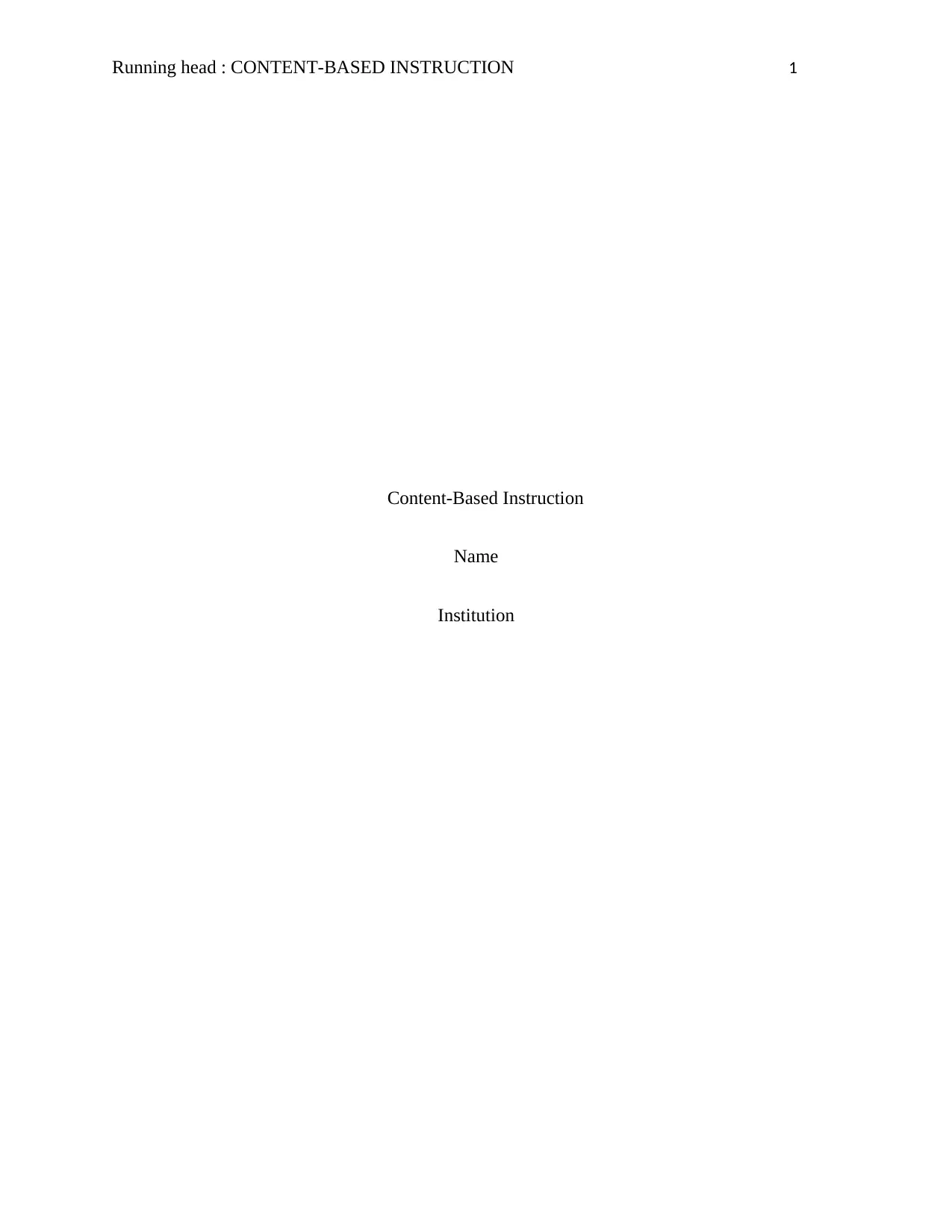
Running head : CONTENT-BASED INSTRUCTION 1
Content-Based Instruction
Name
Institution
Content-Based Instruction
Name
Institution
Secure Best Marks with AI Grader
Need help grading? Try our AI Grader for instant feedback on your assignments.
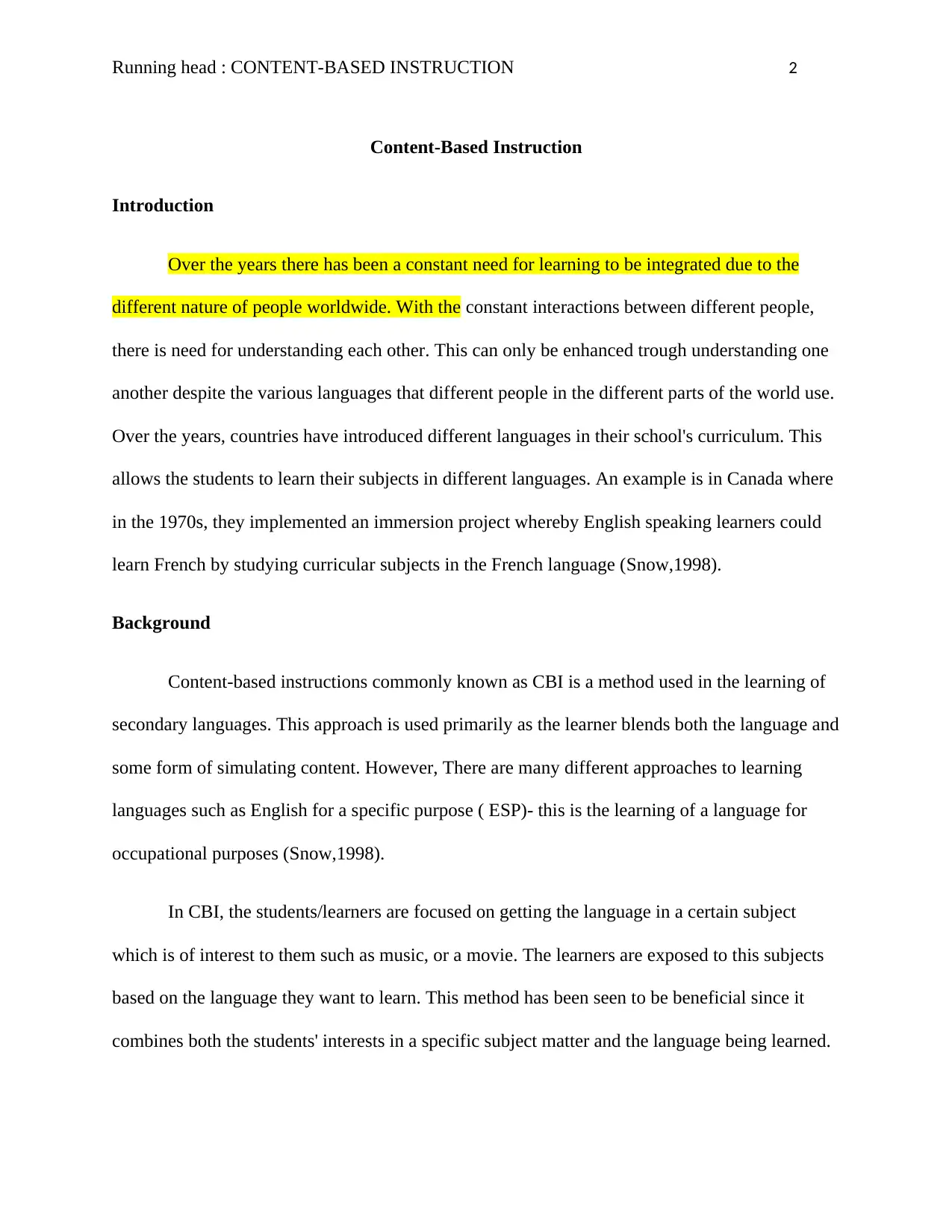
Running head : CONTENT-BASED INSTRUCTION 2
Content-Based Instruction
Introduction
Over the years there has been a constant need for learning to be integrated due to the
different nature of people worldwide. With the constant interactions between different people,
there is need for understanding each other. This can only be enhanced trough understanding one
another despite the various languages that different people in the different parts of the world use.
Over the years, countries have introduced different languages in their school's curriculum. This
allows the students to learn their subjects in different languages. An example is in Canada where
in the 1970s, they implemented an immersion project whereby English speaking learners could
learn French by studying curricular subjects in the French language (Snow,1998).
Background
Content-based instructions commonly known as CBI is a method used in the learning of
secondary languages. This approach is used primarily as the learner blends both the language and
some form of simulating content. However, There are many different approaches to learning
languages such as English for a specific purpose ( ESP)- this is the learning of a language for
occupational purposes (Snow,1998).
In CBI, the students/learners are focused on getting the language in a certain subject
which is of interest to them such as music, or a movie. The learners are exposed to this subjects
based on the language they want to learn. This method has been seen to be beneficial since it
combines both the students' interests in a specific subject matter and the language being learned.
Content-Based Instruction
Introduction
Over the years there has been a constant need for learning to be integrated due to the
different nature of people worldwide. With the constant interactions between different people,
there is need for understanding each other. This can only be enhanced trough understanding one
another despite the various languages that different people in the different parts of the world use.
Over the years, countries have introduced different languages in their school's curriculum. This
allows the students to learn their subjects in different languages. An example is in Canada where
in the 1970s, they implemented an immersion project whereby English speaking learners could
learn French by studying curricular subjects in the French language (Snow,1998).
Background
Content-based instructions commonly known as CBI is a method used in the learning of
secondary languages. This approach is used primarily as the learner blends both the language and
some form of simulating content. However, There are many different approaches to learning
languages such as English for a specific purpose ( ESP)- this is the learning of a language for
occupational purposes (Snow,1998).
In CBI, the students/learners are focused on getting the language in a certain subject
which is of interest to them such as music, or a movie. The learners are exposed to this subjects
based on the language they want to learn. This method has been seen to be beneficial since it
combines both the students' interests in a specific subject matter and the language being learned.
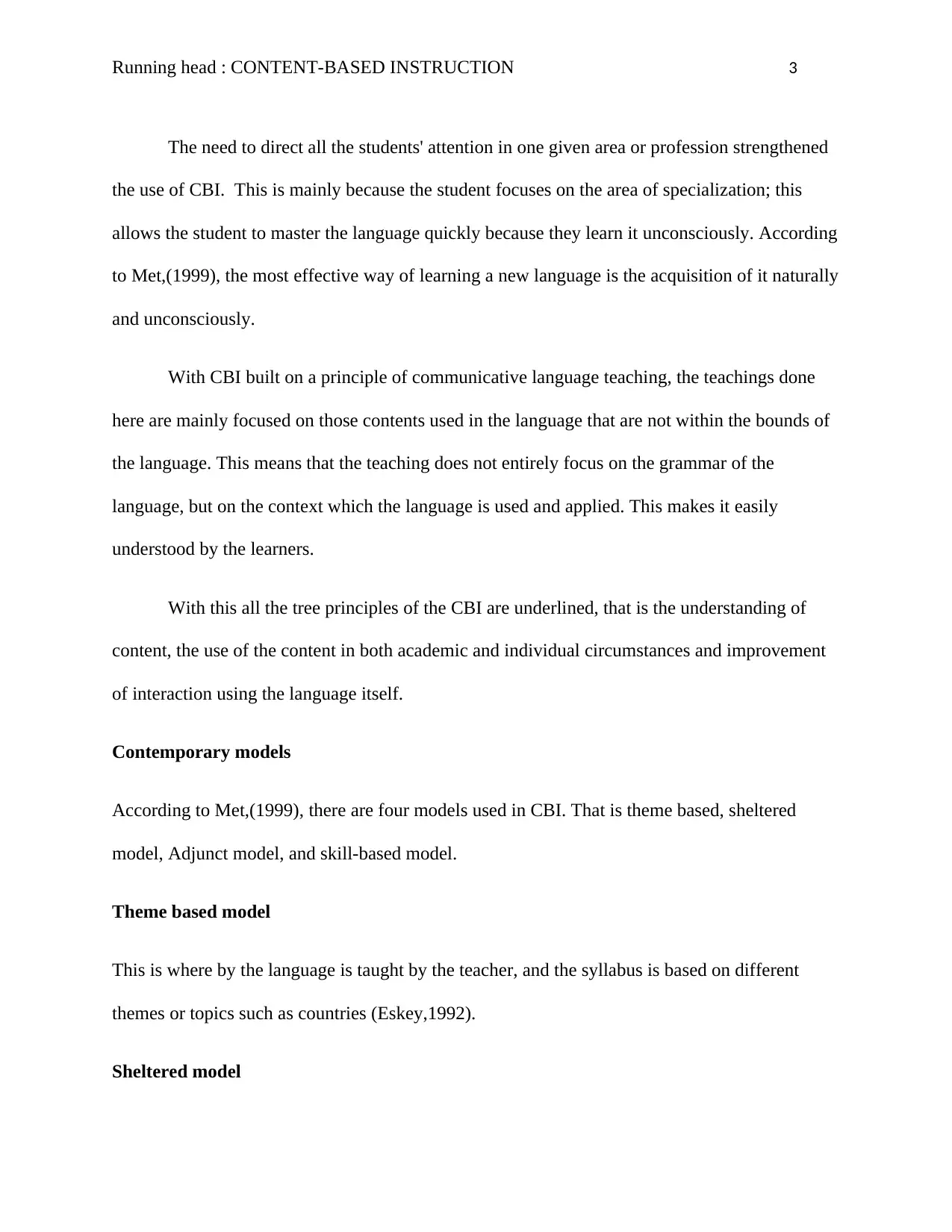
Running head : CONTENT-BASED INSTRUCTION 3
The need to direct all the students' attention in one given area or profession strengthened
the use of CBI. This is mainly because the student focuses on the area of specialization; this
allows the student to master the language quickly because they learn it unconsciously. According
to Met,(1999), the most effective way of learning a new language is the acquisition of it naturally
and unconsciously.
With CBI built on a principle of communicative language teaching, the teachings done
here are mainly focused on those contents used in the language that are not within the bounds of
the language. This means that the teaching does not entirely focus on the grammar of the
language, but on the context which the language is used and applied. This makes it easily
understood by the learners.
With this all the tree principles of the CBI are underlined, that is the understanding of
content, the use of the content in both academic and individual circumstances and improvement
of interaction using the language itself.
Contemporary models
According to Met,(1999), there are four models used in CBI. That is theme based, sheltered
model, Adjunct model, and skill-based model.
Theme based model
This is where by the language is taught by the teacher, and the syllabus is based on different
themes or topics such as countries (Eskey,1992).
Sheltered model
The need to direct all the students' attention in one given area or profession strengthened
the use of CBI. This is mainly because the student focuses on the area of specialization; this
allows the student to master the language quickly because they learn it unconsciously. According
to Met,(1999), the most effective way of learning a new language is the acquisition of it naturally
and unconsciously.
With CBI built on a principle of communicative language teaching, the teachings done
here are mainly focused on those contents used in the language that are not within the bounds of
the language. This means that the teaching does not entirely focus on the grammar of the
language, but on the context which the language is used and applied. This makes it easily
understood by the learners.
With this all the tree principles of the CBI are underlined, that is the understanding of
content, the use of the content in both academic and individual circumstances and improvement
of interaction using the language itself.
Contemporary models
According to Met,(1999), there are four models used in CBI. That is theme based, sheltered
model, Adjunct model, and skill-based model.
Theme based model
This is where by the language is taught by the teacher, and the syllabus is based on different
themes or topics such as countries (Eskey,1992).
Sheltered model
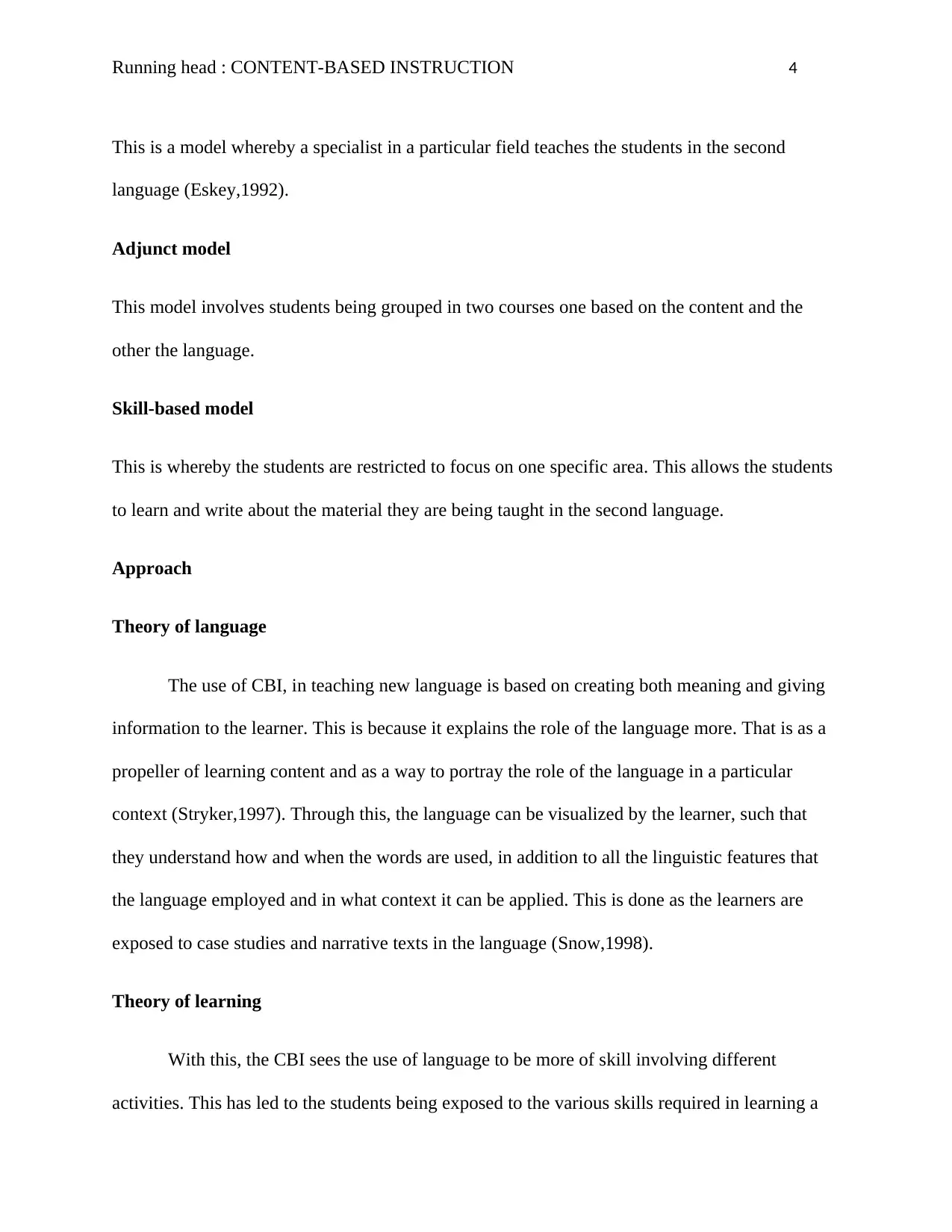
Running head : CONTENT-BASED INSTRUCTION 4
This is a model whereby a specialist in a particular field teaches the students in the second
language (Eskey,1992).
Adjunct model
This model involves students being grouped in two courses one based on the content and the
other the language.
Skill-based model
This is whereby the students are restricted to focus on one specific area. This allows the students
to learn and write about the material they are being taught in the second language.
Approach
Theory of language
The use of CBI, in teaching new language is based on creating both meaning and giving
information to the learner. This is because it explains the role of the language more. That is as a
propeller of learning content and as a way to portray the role of the language in a particular
context (Stryker,1997). Through this, the language can be visualized by the learner, such that
they understand how and when the words are used, in addition to all the linguistic features that
the language employed and in what context it can be applied. This is done as the learners are
exposed to case studies and narrative texts in the language (Snow,1998).
Theory of learning
With this, the CBI sees the use of language to be more of skill involving different
activities. This has led to the students being exposed to the various skills required in learning a
This is a model whereby a specialist in a particular field teaches the students in the second
language (Eskey,1992).
Adjunct model
This model involves students being grouped in two courses one based on the content and the
other the language.
Skill-based model
This is whereby the students are restricted to focus on one specific area. This allows the students
to learn and write about the material they are being taught in the second language.
Approach
Theory of language
The use of CBI, in teaching new language is based on creating both meaning and giving
information to the learner. This is because it explains the role of the language more. That is as a
propeller of learning content and as a way to portray the role of the language in a particular
context (Stryker,1997). Through this, the language can be visualized by the learner, such that
they understand how and when the words are used, in addition to all the linguistic features that
the language employed and in what context it can be applied. This is done as the learners are
exposed to case studies and narrative texts in the language (Snow,1998).
Theory of learning
With this, the CBI sees the use of language to be more of skill involving different
activities. This has led to the students being exposed to the various skills required in learning a
Secure Best Marks with AI Grader
Need help grading? Try our AI Grader for instant feedback on your assignments.
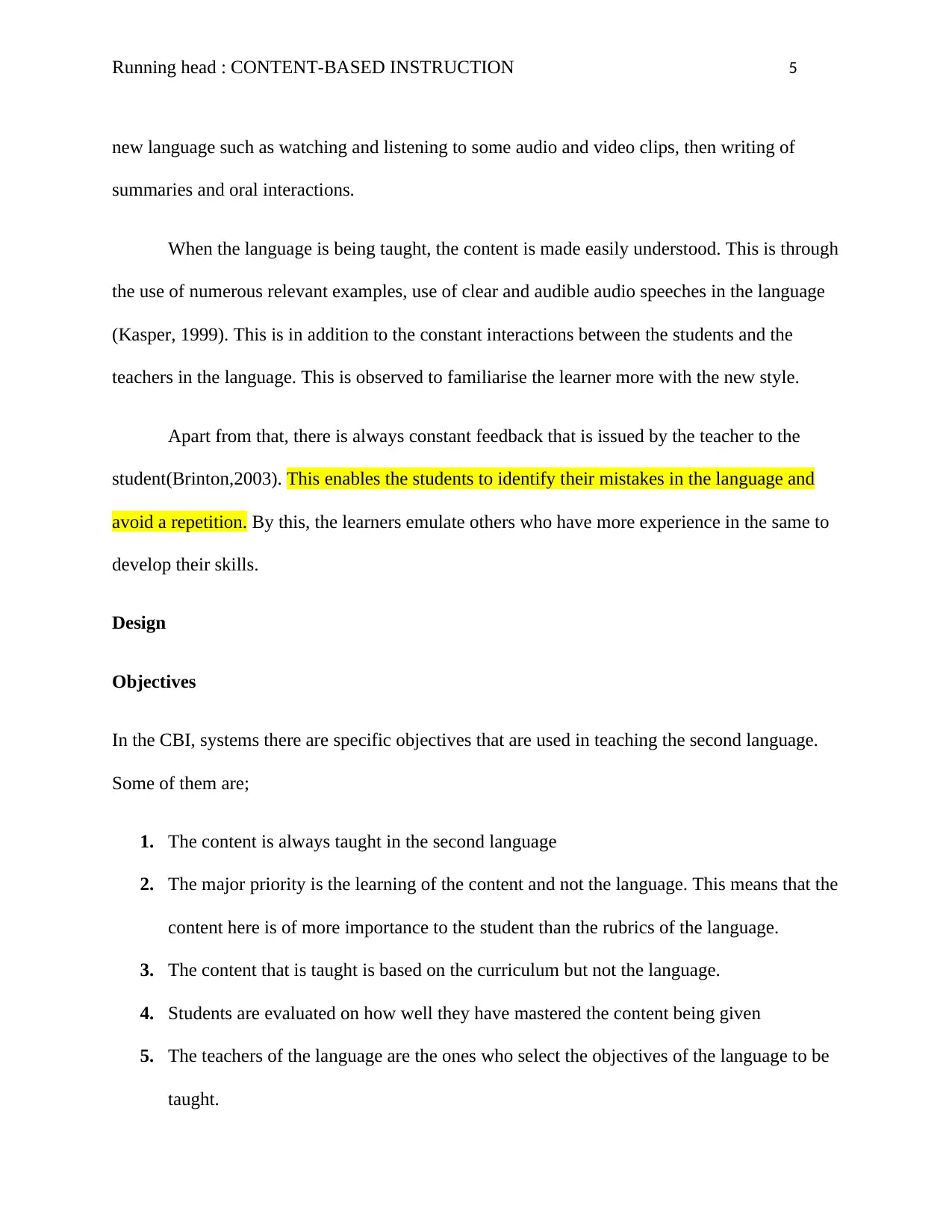
Running head : CONTENT-BASED INSTRUCTION 5
new language such as watching and listening to some audio and video clips, then writing of
summaries and oral interactions.
When the language is being taught, the content is made easily understood. This is through
the use of numerous relevant examples, use of clear and audible audio speeches in the language
(Kasper, 1999). This is in addition to the constant interactions between the students and the
teachers in the language. This is observed to familiarise the learner more with the new style.
Apart from that, there is always constant feedback that is issued by the teacher to the
student(Brinton,2003). This enables the students to identify their mistakes in the language and
avoid a repetition. By this, the learners emulate others who have more experience in the same to
develop their skills.
Design
Objectives
In the CBI, systems there are specific objectives that are used in teaching the second language.
Some of them are;
1. The content is always taught in the second language
2. The major priority is the learning of the content and not the language. This means that the
content here is of more importance to the student than the rubrics of the language.
3. The content that is taught is based on the curriculum but not the language.
4. Students are evaluated on how well they have mastered the content being given
5. The teachers of the language are the ones who select the objectives of the language to be
taught.
new language such as watching and listening to some audio and video clips, then writing of
summaries and oral interactions.
When the language is being taught, the content is made easily understood. This is through
the use of numerous relevant examples, use of clear and audible audio speeches in the language
(Kasper, 1999). This is in addition to the constant interactions between the students and the
teachers in the language. This is observed to familiarise the learner more with the new style.
Apart from that, there is always constant feedback that is issued by the teacher to the
student(Brinton,2003). This enables the students to identify their mistakes in the language and
avoid a repetition. By this, the learners emulate others who have more experience in the same to
develop their skills.
Design
Objectives
In the CBI, systems there are specific objectives that are used in teaching the second language.
Some of them are;
1. The content is always taught in the second language
2. The major priority is the learning of the content and not the language. This means that the
content here is of more importance to the student than the rubrics of the language.
3. The content that is taught is based on the curriculum but not the language.
4. Students are evaluated on how well they have mastered the content being given
5. The teachers of the language are the ones who select the objectives of the language to be
taught.
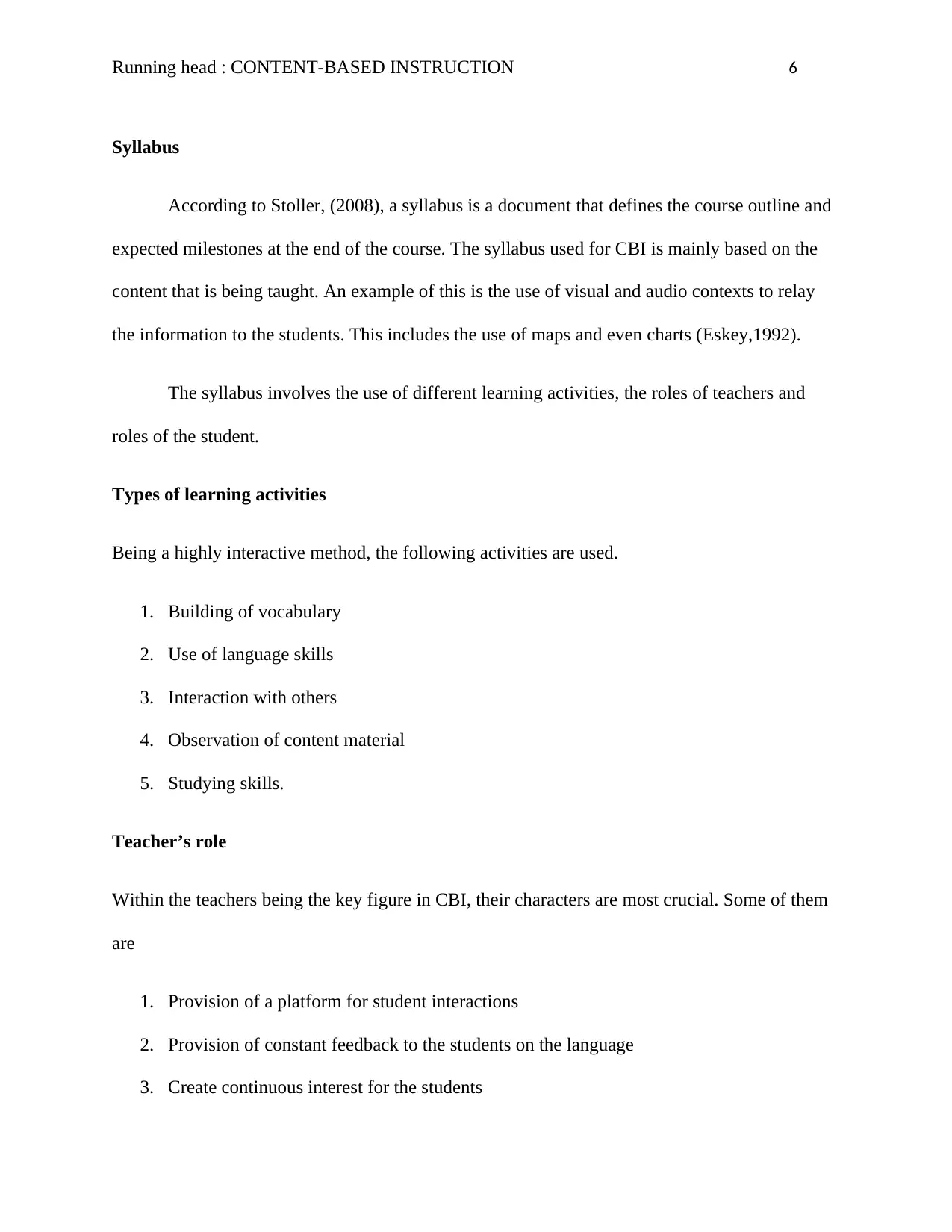
Running head : CONTENT-BASED INSTRUCTION 6
Syllabus
According to Stoller, (2008), a syllabus is a document that defines the course outline and
expected milestones at the end of the course. The syllabus used for CBI is mainly based on the
content that is being taught. An example of this is the use of visual and audio contexts to relay
the information to the students. This includes the use of maps and even charts (Eskey,1992).
The syllabus involves the use of different learning activities, the roles of teachers and
roles of the student.
Types of learning activities
Being a highly interactive method, the following activities are used.
1. Building of vocabulary
2. Use of language skills
3. Interaction with others
4. Observation of content material
5. Studying skills.
Teacher’s role
Within the teachers being the key figure in CBI, their characters are most crucial. Some of them
are
1. Provision of a platform for student interactions
2. Provision of constant feedback to the students on the language
3. Create continuous interest for the students
Syllabus
According to Stoller, (2008), a syllabus is a document that defines the course outline and
expected milestones at the end of the course. The syllabus used for CBI is mainly based on the
content that is being taught. An example of this is the use of visual and audio contexts to relay
the information to the students. This includes the use of maps and even charts (Eskey,1992).
The syllabus involves the use of different learning activities, the roles of teachers and
roles of the student.
Types of learning activities
Being a highly interactive method, the following activities are used.
1. Building of vocabulary
2. Use of language skills
3. Interaction with others
4. Observation of content material
5. Studying skills.
Teacher’s role
Within the teachers being the key figure in CBI, their characters are most crucial. Some of them
are
1. Provision of a platform for student interactions
2. Provision of constant feedback to the students on the language
3. Create continuous interest for the students
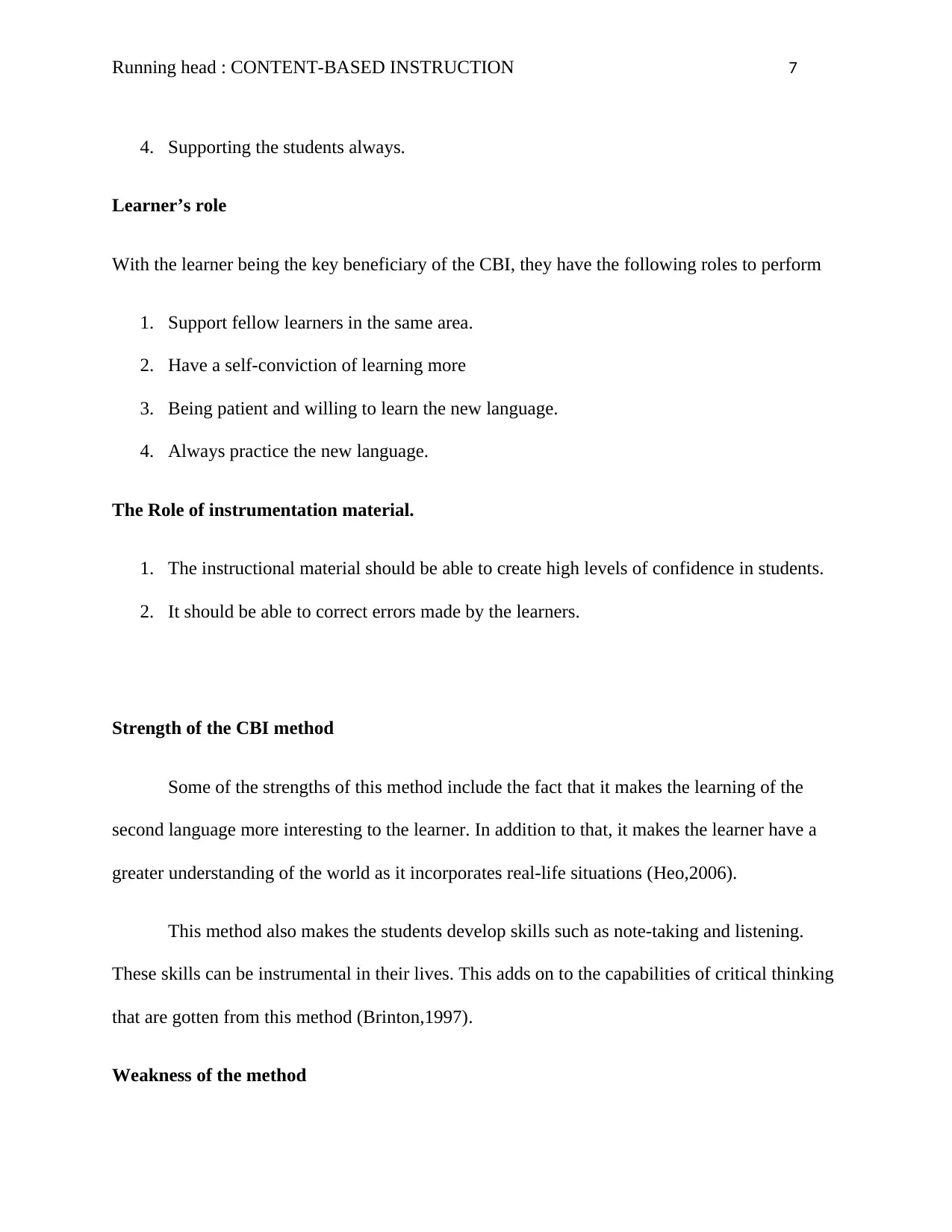
Running head : CONTENT-BASED INSTRUCTION 7
4. Supporting the students always.
Learner’s role
With the learner being the key beneficiary of the CBI, they have the following roles to perform
1. Support fellow learners in the same area.
2. Have a self-conviction of learning more
3. Being patient and willing to learn the new language.
4. Always practice the new language.
The Role of instrumentation material.
1. The instructional material should be able to create high levels of confidence in students.
2. It should be able to correct errors made by the learners.
Strength of the CBI method
Some of the strengths of this method include the fact that it makes the learning of the
second language more interesting to the learner. In addition to that, it makes the learner have a
greater understanding of the world as it incorporates real-life situations (Heo,2006).
This method also makes the students develop skills such as note-taking and listening.
These skills can be instrumental in their lives. This adds on to the capabilities of critical thinking
that are gotten from this method (Brinton,1997).
Weakness of the method
4. Supporting the students always.
Learner’s role
With the learner being the key beneficiary of the CBI, they have the following roles to perform
1. Support fellow learners in the same area.
2. Have a self-conviction of learning more
3. Being patient and willing to learn the new language.
4. Always practice the new language.
The Role of instrumentation material.
1. The instructional material should be able to create high levels of confidence in students.
2. It should be able to correct errors made by the learners.
Strength of the CBI method
Some of the strengths of this method include the fact that it makes the learning of the
second language more interesting to the learner. In addition to that, it makes the learner have a
greater understanding of the world as it incorporates real-life situations (Heo,2006).
This method also makes the students develop skills such as note-taking and listening.
These skills can be instrumental in their lives. This adds on to the capabilities of critical thinking
that are gotten from this method (Brinton,1997).
Weakness of the method
Paraphrase This Document
Need a fresh take? Get an instant paraphrase of this document with our AI Paraphraser
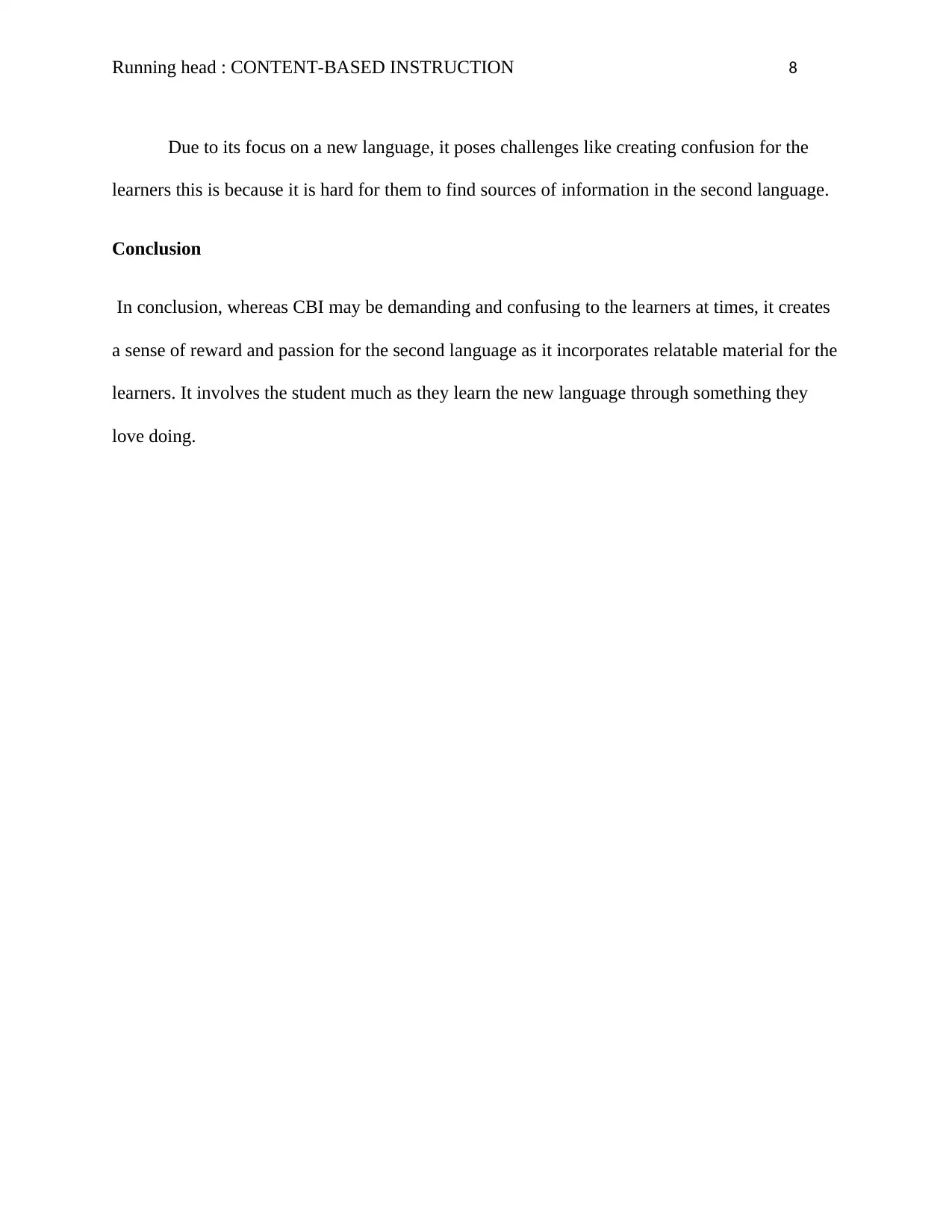
Running head : CONTENT-BASED INSTRUCTION 8
Due to its focus on a new language, it poses challenges like creating confusion for the
learners this is because it is hard for them to find sources of information in the second language.
Conclusion
In conclusion, whereas CBI may be demanding and confusing to the learners at times, it creates
a sense of reward and passion for the second language as it incorporates relatable material for the
learners. It involves the student much as they learn the new language through something they
love doing.
Due to its focus on a new language, it poses challenges like creating confusion for the
learners this is because it is hard for them to find sources of information in the second language.
Conclusion
In conclusion, whereas CBI may be demanding and confusing to the learners at times, it creates
a sense of reward and passion for the second language as it incorporates relatable material for the
learners. It involves the student much as they learn the new language through something they
love doing.
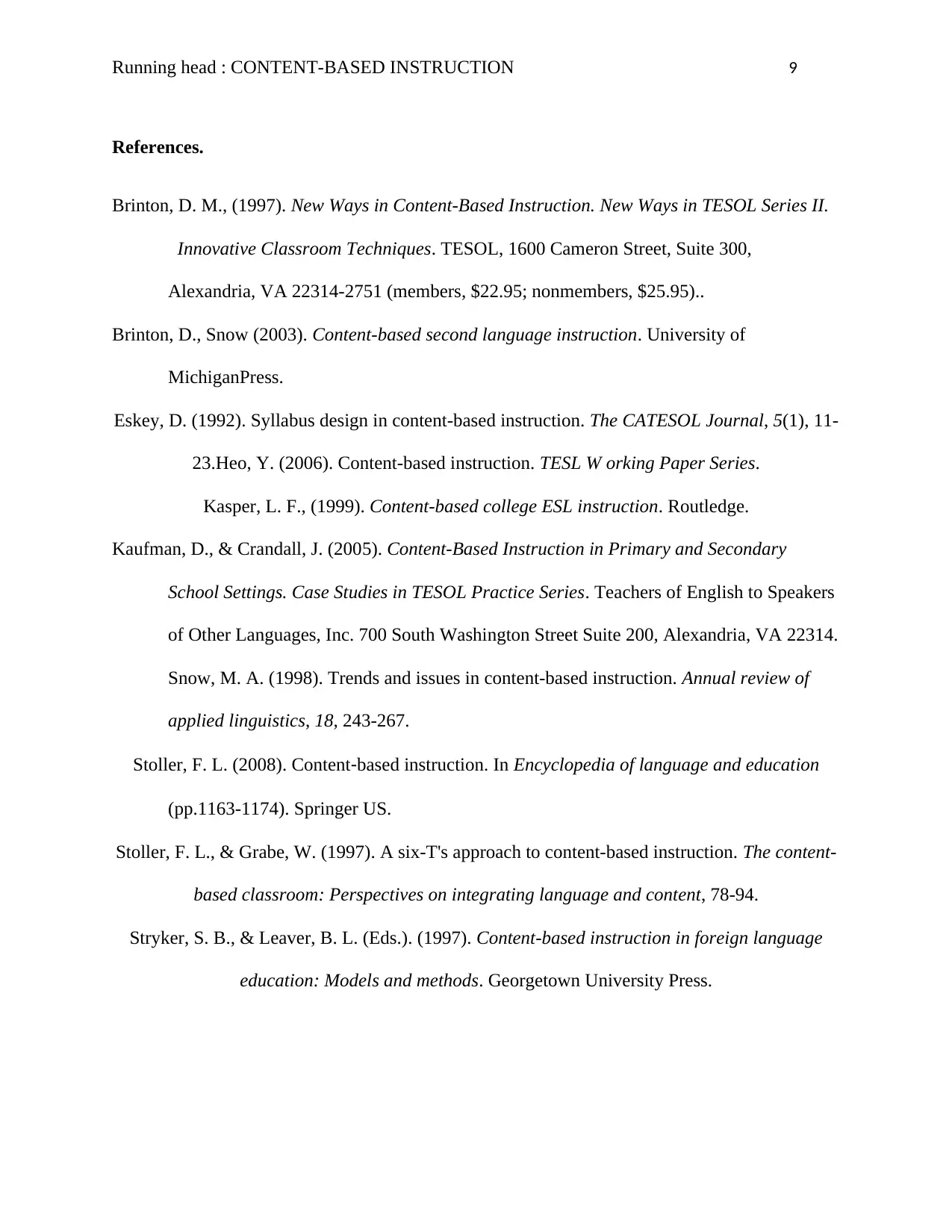
Running head : CONTENT-BASED INSTRUCTION 9
References.
Brinton, D. M., (1997). New Ways in Content-Based Instruction. New Ways in TESOL Series II.
Innovative Classroom Techniques. TESOL, 1600 Cameron Street, Suite 300,
Alexandria, VA 22314-2751 (members, $22.95; nonmembers, $25.95)..
Brinton, D., Snow (2003). Content-based second language instruction. University of
MichiganPress.
Eskey, D. (1992). Syllabus design in content-based instruction. The CATESOL Journal, 5(1), 11-
23.Heo, Y. (2006). Content-based instruction. TESL W orking Paper Series.
Kasper, L. F., (1999). Content-based college ESL instruction. Routledge.
Kaufman, D., & Crandall, J. (2005). Content-Based Instruction in Primary and Secondary
School Settings. Case Studies in TESOL Practice Series. Teachers of English to Speakers
of Other Languages, Inc. 700 South Washington Street Suite 200, Alexandria, VA 22314.
Snow, M. A. (1998). Trends and issues in content-based instruction. Annual review of
applied linguistics, 18, 243-267.
Stoller, F. L. (2008). Content‐based instruction. In Encyclopedia of language and education
(pp.1163-1174). Springer US.
Stoller, F. L., & Grabe, W. (1997). A six-T's approach to content-based instruction. The content-
based classroom: Perspectives on integrating language and content, 78-94.
Stryker, S. B., & Leaver, B. L. (Eds.). (1997). Content-based instruction in foreign language
education: Models and methods. Georgetown University Press.
References.
Brinton, D. M., (1997). New Ways in Content-Based Instruction. New Ways in TESOL Series II.
Innovative Classroom Techniques. TESOL, 1600 Cameron Street, Suite 300,
Alexandria, VA 22314-2751 (members, $22.95; nonmembers, $25.95)..
Brinton, D., Snow (2003). Content-based second language instruction. University of
MichiganPress.
Eskey, D. (1992). Syllabus design in content-based instruction. The CATESOL Journal, 5(1), 11-
23.Heo, Y. (2006). Content-based instruction. TESL W orking Paper Series.
Kasper, L. F., (1999). Content-based college ESL instruction. Routledge.
Kaufman, D., & Crandall, J. (2005). Content-Based Instruction in Primary and Secondary
School Settings. Case Studies in TESOL Practice Series. Teachers of English to Speakers
of Other Languages, Inc. 700 South Washington Street Suite 200, Alexandria, VA 22314.
Snow, M. A. (1998). Trends and issues in content-based instruction. Annual review of
applied linguistics, 18, 243-267.
Stoller, F. L. (2008). Content‐based instruction. In Encyclopedia of language and education
(pp.1163-1174). Springer US.
Stoller, F. L., & Grabe, W. (1997). A six-T's approach to content-based instruction. The content-
based classroom: Perspectives on integrating language and content, 78-94.
Stryker, S. B., & Leaver, B. L. (Eds.). (1997). Content-based instruction in foreign language
education: Models and methods. Georgetown University Press.
1 out of 9
Related Documents
Your All-in-One AI-Powered Toolkit for Academic Success.
+13062052269
info@desklib.com
Available 24*7 on WhatsApp / Email
![[object Object]](/_next/static/media/star-bottom.7253800d.svg)
Unlock your academic potential
© 2024 | Zucol Services PVT LTD | All rights reserved.





